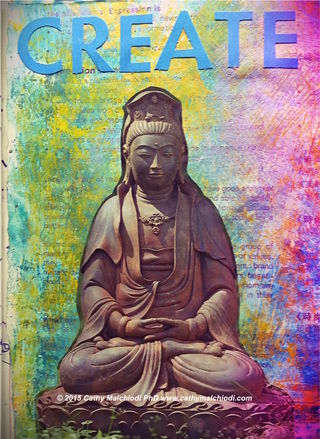This bold statement that “making art…may be as important to your health as balanced nutrition, regular exercise, or meditation.” may had not enough support as there were few studies at that time. But researchers over the past few years proved that, "Creativity is a wellness practice and we now know there are numerous reasons to make it part of your “wellness resolutions.”
In 2010, a review of existing literature on the benefits of the arts (music, visual arts, dance and writing) by Stuckey and Noble considered more than 100 studies, concluding that creative expression has a powerful impact on health and well-being on various patient populations. Most of these studies concur that participation and/or engagement in the arts have a variety of outcomes including a decrease in depressive symptoms, an increase in positive emotions, reduction in stress responses, and, in some cases, even improvements in immune system functioning; visual art therapy, for example, is trending toward many of these health gains and more. Even engagement in the arts as a viewer can have an impact, but if you really want to benefit from the arts for wellness, studies continue to show that your active participation is the best bet (Bolwerk et al, 2014).
As of 2015, additional studies indicate that creative self-expression and exposure to the arts have wide-ranging effects on not only cognitive and psychosocial health, but also physical conditions such as Parkinson’s disease, various forms of dementia and cancer. One of the most compelling studies was recently conducted by the Mayo Clinic and proposed that people who engage in art activities (painting, drawing and sculpting; crafts, like woodworking, pottery, ceramics, quilting, quilling and sewing) in middle and old age may delay cognitive decline in very old age. These findings underscore the idea that it is possible to build a “cognitive reserve” through engaging in novel, creative experiences that have a protective effect on the brain. According to the principle investigator, “Our study supports the idea that engaging the mind may protect neurons, or the building blocks of the brain, from dying, stimulate growth of new neurons, or may help recruit new neurons to maintain cognitive activities in old age” (American Academy of Neurology, 2015).

In brief, creativity is increasingly being validated as a potent mind-body approach as well as a cost-effective intervention to address a variety of challenges throughout the lifespan. While there are limitations to many of the existing studies such as sample size and research methodology, the overall outcomes complement what has been intuited by humans over millennia—that creative expression is good for us in one way or another. These simple wellness practices come in many readily available forms including the formalized approaches found in the creative arts therapies and expressive arts therapy, participation in arts within healthcare settings, and a variety of creative activities for personal self-care.
Psychologist Mihaly Csikszentmihalyi said during his seminal TED talk in 2004
"When we are involved in creativity, we feel that we are living more fully than during the rest of life.” Building on Csikszentmihalyi's observation, I’ll venture to make one more bold statement about the power of creative expression and the arts as wellness practices—it does not fully manifest from completing an adult coloring book sheet. It's our capacity to actually "create" is where we begin to live more fully, experience transformation, and recover the core of what it means to heal. It is your authentic expression through art making, music, song, movement, writing, and other forms of arts-based imagination that are central to the equation of why creativity is a wellness practice. So go make something and be well.
Cathy Malchiodi, PhD


No comments:
Post a Comment